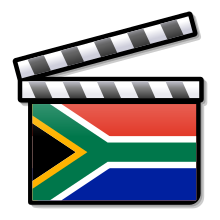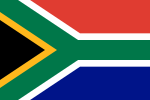Cinema of South Africa
| Cinema of South Africa | |
|---|---|
 | |
| No. of screens | 857 (2010)[1] |
| • Per capita | 1.9 per 100,000 (2010)[1] |
| Main distributors | Ster-Kinekor 38.8% Nu-Metro 35.7% Uip 21.7%[2] |
| Produced feature films (2016)[3] | |
| Total | 28 |
| Number of admissions (2011)[4] | |
| Total | 22,400,000 |
| Gross box office (2016)[3] | |
| Total | R1.14 billion |
| National films | R69 million (6%) |
The cinema of South Africa refers to the films and film industry of the nation of South Africa. Many foreign films have been produced about South Africa (usually involving race relations).
The first South African film to achieve international acclaim and recognition was the 1980 comedy The Gods Must Be Crazy, written, produced and directed by Jamie Uys. Set in the Kalahari, it told the story about how life in the community of Bushmen is changed when a Coke bottle, thrown out of an airplane, suddenly lands from the sky. Despite the fact that the film presented an incorrect perspective of the Khoisan san people, by framing them as a primitive society enlightened by the modernity of a falling Coke bottle. The late Jamie Uys, who wrote and directed The Gods Must Be Crazy, also had success overseas in the 1970s with his films Funny People and Funny People II, similar to the TV series Candid Camera in the United States. Leon Schuster's You Must Be Joking! films are in the same genre, and were popular among the white population of South Africa during apartheid.
Another high-profile film portraying South Africa in recent years was District 9. Directed by Neill Blomkamp, a native South African, and produced by Lord of the Rings trilogy helmer Peter Jackson, the action/science-fiction film depicts a sub-class of alien refugees forced to live in the slums of Johannesburg in what many saw as a creative allegory for apartheid. The film was a critical and commercial success worldwide, and was nominated for four Academy Awards, including Best Picture, at the 82nd Academy Awards.
Silent Era[]

| Part of a series on the |
| Culture of South Africa |
|---|
 |
| History |
| People |
| Cuisine |
| Religion |
| Art |
| Sport |
|
| Cinema of South Africa |
|---|
 |
| List of South African films |
| By language |
| Afrikaans |
The first film studio in South Africa, Killarney Film Studios, was established in 1915 in Johannesburg by American business tycoon Isidore W. Schlesinger when he traveled to South Africa against his family's wishes after he read about the discovery of gold in Witwatersrand and was interested in exploring what he could find.[5]
During the 1910s and 1920s, a significant amount of South African films were made in or around Durban. These films often made use of the dramatic scenery available in rural KwaZulu-Natal, particularly the Drakensberg region. KwaZulu-Natal also served as the appropriate location for historical films such as De Voortrekkers (1916) and The Symbol of Sacrifice (1918). American filmmaker Lorimer Johnston directed several films in the area in the late 1910s which starred American actresses Edna Flugrath and Caroline Frances Cooke. Despite the participation of Johnson, Flugrath and Cooke, these were South African productions featuring local actors and stories.
Sound Era[]
Sarie Marais, the first Afrikaans-language sound film, was released in 1931. Subsequent sound releases such as Die Wildsboudjie (1948), a 1949 Sarie Marais remake, and Daar doer in die bosveld (1950) continued to cater primarily to white, Afrikaans-speaking audiences.
The 1950s saw an increased use of South African locations and talent by international filmmakers. British co-productions like Coast of Skeletons (1956) and American co-productions like The Cape Town Affair (1967) reflected a growing trend of shooting in real locations, rather than using backlots.
International Productions[]
From 2009, there was an increased use of South African locations and talent by international film studios. US productions like District 9 (2009), Chronicle (2012), Avengers: Age of Ultron (2015), The Dark Tower (2017), Tomb Raider (2018), The Kissing Booth (2018), Maze Runner: The Death Cure (2018), Escape Room (2019) and Bloodshot (2020) reflect a growing trend by large international houses to use Cape Town, Johannesburg and other South African locations for their film productions.[6][7]
The 3 major South African film distributors[]
Listed alongside each distributor are the studios they represent:
- : 20th Century Studios, Warner Bros., New Line Cinema, DreamWorks Pictures, DreamWorks Animation.
- Ster-Kinekor: Walt Disney Pictures, Sony Pictures
- United International Pictures: Universal Pictures, Paramount Pictures,
See also[]
- List of South African films
- Media of South Africa
- Cinema of the world
- World cinema
- African cinema
- South African Film and Television Awards
References[]
- ^ a b "Table 8: Cinema Infrastructure – Capacity". UNESCO Institute for Statistics. Archived from the original on 24 December 2018. Retrieved 5 November 2013.
- ^ "Box Office Report: South Africa (January – December 2013)" (PDF). National Film and Video Foundation South Africa. Retrieved 14 August 2014.
- ^ a b "South African Box Office 2016" (PDF). National Film and Video Foundation. Retrieved 15 January 2018.
- ^ "Table 11: Exhibition – Admissions & Gross Box Office (GBO)". UNESCO Institute for Statistics. Archived from the original on 24 December 2018. Retrieved 5 November 2013.
- ^ Anonymous (21 March 2011). "A History of the South African Film Industry timeline 1895-2003". South African History Online. Retrieved 4 November 2017.
- ^ "20 Films shot in South Africa - TravelGround Blog". www.travelground.com. Retrieved 12 August 2020.
- ^ "Did you know that these Hollywood movies were shot in SA?". www.iol.co.za. Retrieved 12 August 2020.
Further reading[]
- Botha, Martin. South African Cinema 1896-2010 . Bristol: Intellect, 2012
- Blignaut, Johan, and Botha, Martin. Movies, Moguls, Mavericks : South African Cinema, 1979-1991 . Cape Town: Showdata, 1992
- Maingard, Jacqueline. South African National Cinema . London ;: Routledge, 2007.
- Tomaselli, Keyan G. Encountering Modernity : Twentieth Century South African Cinemas . Amsterdam: Rozenberg, 2006
- Balseiro, Isabel., and Ntongela. Masilela. To Change Reels : Film and Culture in South Africa . Detroit, Mich: Wayne State University Press, 2003
- Modisane, Litheko. South Africa’s Renegade Reels : the Making and Public Lives of Black-Centered Films . 1st ed. New York: Palgrave Macmillan, 2013
- Tomaselli, Keyan G. The Cinema of Apartheid : Race and Class in South African Film . London: Routledge, 1989.
External links[]
| Wikimedia Commons has media related to Cinema of South Africa. |
- The Latest News, Job Offers and Opportunities in the South African Film Industry
- South African movie website
- South Africa's film industry Focus on the industry – SouthAfrica.info
- African Media Program. Comprehensive database of African media
- Timeline: 1895–2003 A History of the South African Film Industry
- The South African Movie Database Showcasing the South African industry
- The Callsheet Newspaper Monthly South African film industry trade publication
This film-related list is incomplete; you can help by . (October 2021) |
- Cinema of South Africa
- Industry in South Africa
- South African films